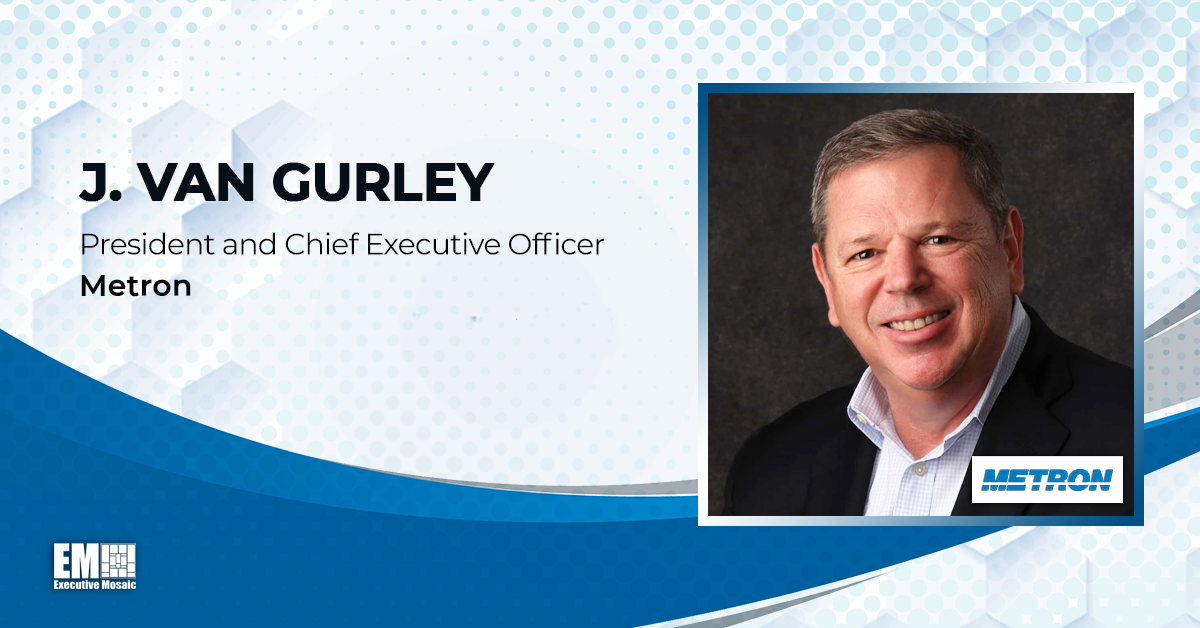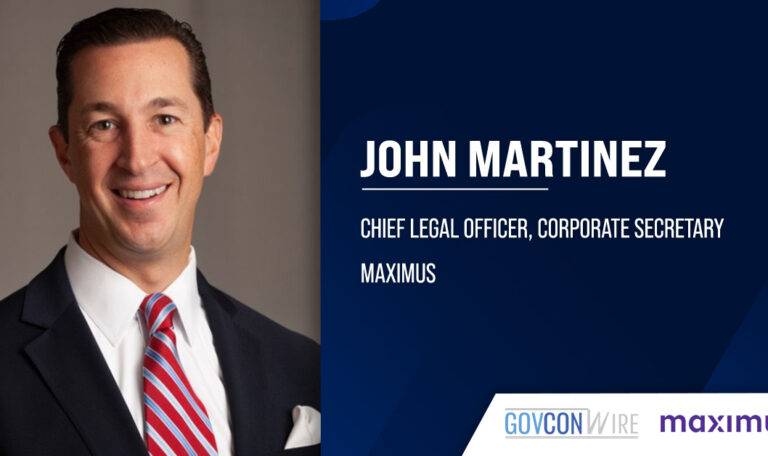Van Gurley’s successful career in government contracting might appear largely happenstance. “I typically said yes and would walk through that door even when I wasn’t sure what was on the other side of it,” Gurley told us about opportunities he encountered that proved invaluable later in his career.
He began his working life as a submarine officer and oceanographer in the U.S. Navy, where he was planning to serve for just four years. That ended up turning into 26 years serving in positions of increasing responsibility, including director of antisubmarine warfare programs in the Naval Oceanography Operations Command and later commanding officer of said command. Critical for his later roles at Metron, Gurley saw first-hand capability gaps and needs from an end-user perspective over the course of many operational assignments.
His path from the Navy to research, scientific and software solutions company Metron is a similarly non-linear and circuitous one, but Gurley couldn’t be more pleased with the place he has called home for the last 11 years. He worked his way up from senior manager, to chief operating officer, to being appointed president and CEO in January 2019, all the while leveraging experiences from his active duty days.
Gurley recently sat down with GovCon Wire to discuss how he and his team are positioning Metron to be “the most innovative mid-size company” through new work in artificial intelligence, unmanned underwater vehicles and more. He also shed light on the business challenges of innovation in the field and the company’s principal priorities.
We often discuss innovation from the technical or capability side. What unique challenges have you seen on the business side of innovation that haven’t been addressed or discussed enough?
There’s a lot of talk about speed to capability, and we are firm believers in moving as fast as possible to get new, game-changing technologies out the door and into the hands of the operators. The big pressure and pain point is speed to contract and contract continuity. It’s talked about, but it needs to be emphasized more because it needs fixing. Typically, for a project that we are going to take from the very beginning all the way through transition into a program of record, it may have two or three different sponsors along the way, each with a different contract. The gaps between those contracts can become huge problems, so we must sustain work through some means while we’re waiting for the contract authorities to figure out how to move from one contract to the next.
Typically, that means that we must do a lot of contractual maneuvers to find a partner who has a temporary vehicle to keep the work going, because if the work stops, as a small business, our team will get dispersed to other projects and it’ll be very hard to pull the team back together when the government finally decides it’s time to restart. So there’s a lot of churn that happens, and this churn has first, second and third-order impacts. First, it takes up time and energy that should be focused on capability building, not contractual maneuvers. Second, it costs the government more money. We have to pass money through a third party to get to us rather than having the contract directly in hand, and everybody takes a pass-through fee off the top.
Third, especially for highly classified projects, when we’re working on a temporary pass-through contract vehicle, it is very difficult to get clearances done, to get facilities cleared, to get communication connections in because those sponsors want to see the final contract in place before they’ll do it. These are all impediments to getting innovative solutions out the door.
One other piece that we’ve seen more and more—and that there has been discussion around, especially for a software company—is the process of getting things tested, accepted and getting authorities to operate, or ATOs, in place so we can actually turn things on and use them. This came up at a House subcommittee meeting on the Hill a few weeks ago, about the fact that Congress has authorized things like continuous ATOs, but the Pentagon hasn’t implemented it. We recently had a project where we had an ATO pending for over two years and then the approval agency finally, after dragging it on for two years, said, “Well, it’s taken too long, so let’s just cancel the whole thing and let you start over.” That’s not helpful.
What can you tell us about the company’s priorities? What do you hope to accomplish, and are there any new markets in the federal sector that you’re keeping an eye on?
Metron’s whole approach starts with assembling a world-class technical team, dedicating ourselves to technical excellence and focusing on the needs and problems of the end-user so that we craft the right technical solutions tailored to the most critical problems. In terms of our company goals and priorities, we aim to be recognized as the most innovative mid-size company by consistently delivering solutions that tackle the toughest problems that hold the greatest significance. We strive to maintain our unique blend of small business agility while upholding disciplined execution characteristics of a mid-tier company. This balance has enabled us to successfully navigate through the entire spectrum of development, from early-stage research and development at the Defense Advanced Research Projects Agency to transitioning into U.S. Navy programs of record. Additionally, our success hinges on our deep connections with sponsors, warfighters and operators, which provide invaluable insight and context guiding all our endeavors.
In terms of exploring new markets, we identified significant opportunities in artificial intelligence-enabled decision support tools. Drawing upon decades of experience, we’ve innovatively developed applications addressing mission planning amid risk and uncertainty. This diverges from the conventional approach to AI by many in the defense sector, yet we’ve demonstrated its potential through several successful programs.
Moreover, we are closely monitoring the lessons learned from current events in Ukraine and the Red Sea and how they apply to our initiatives. As we transition towards a landscape characterized by a larger number of smaller systems working together to enhance capabilities, our focus on autonomy and data fusion becomes increasingly vital. While some of our efforts are already being applied in this context, I anticipate further opportunities as the proliferation of vehicles and systems continues. Consequently, scaling up our endeavors in data fusion and mission orchestration will be pivotal in capturing opportunities within this expanding market.
You just announced a recent partnership with Cellula Robotics. Can you tell us more about that partnership and what it means to our defense programs?
Metron has been deeply involved in long-duration resilient autonomy for over a decade. We were pioneers in a large Office of Naval Research Innovative Naval Prototype program that spanned the 2010s. Now, we have the opportunity to leverage all that we’ve learned and merge it with a vehicle that can truly exploit these capabilities.
While “disruption” is a term often used liberally in D.C., the potential of combining Cellula Robotics’ hydrogen fuel cell technology for endurance and range, alongside a modular vehicle design for multiple payloads and our resilient mission autonomy, is genuinely disruptive in the large unmanned underwater vehicle market.
This opens up an entirely new paradigm for undersea missions, shifting from a 24-hour to a 45-plus-day endurance model. The fusion of vehicle capabilities with our autonomy—capable of dynamically managing and replanning multiple mission objectives in dynamic and uncertain environments without human intervention—presents a unique set of capabilities in the undersea domain. We’ve initiated conversations with Department of Defense offices about prototyping and testing to validate the technologies we’re integrating. Additionally, we’re exploring opportunities in the offshore energy market, offering a zero-carbon solution for ocean bottom survey and infrastructure inspections at a lower cost compared to current methods involving large surface support ships and their diesel engines.
This technology not only has promising economic implications for the offshore energy sector but also serves as a proving ground for advancing UUV technology more rapidly than traditional defense markets. We’ve been in discussions for over a year, recently solidifying a partnership agreement and issuing a press release. Further announcements are expected as we progress into sea trials and integrate the two technologies. Our teams are already collaborating closely, and it promises to be an exciting and productive year ahead.
Metron is an employee-owned company. Talk to me about the importance of this in attracting new talent and bringing value to the customer.
Being 100 percent employee-owned provides us with the financial stability to take the long view. I can focus—and so can the team—on the technical quality of our work and the opportunity spaces where we can have a bigger impact, without worrying about quarterly earnings calls or meeting an exit timeline for outside investors. The incentives of having an employee stock ownership plan, or ESOP, include being tax-free at the federal level, and there are some new authorities in the National Defense Authorization Act that provide ESOPs a preference in certain types of contract awards, which is very exciting for us. This gives me the ability to generate additional income and reinvest it in the company.
We can make independent infrastructure investments without taking on debt or outside investment and reward our employees through various perks, including the ability for all of them to participate in the company’s success through company equity.
Every employee at Metron is an employee-owner, and this is part of a broader cultural foundation where we empower our workforce at every level to ask questions, offer inputs and be part of crafting the solution. I’m extremely transparent, sharing company goals, progress and financial information every month. This is part of a larger employee engagement culture that is the foundation of how we recruit and retain a world-class staff. Everyone knows they are a part of something bigger, immediately gets a chance to contribute, can see the impact of their work and gets to collaborate with incredible peers on challenging projects.
Finally, this approach shows up in ways that are gratifying when they come about. Every year, we conduct an employment alignment survey through a third-party company called CultureID, which measures how engaged our employees are. Our scores for the last survey, released at the beginning of this year, were at the top of the chart. We qualified in the top 10 percent of all companies nationwide, earning the Elite Company Culture Award. We’re very proud of this recognition, and it’s reflected in our retention statistics. We have employees who have been with us for 40 years, a testament to the strength of our culture and the dedication of our team.















